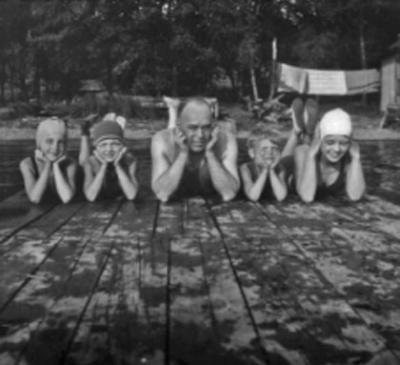
Red Yarn and a Safety Pin

Grandma Ada said, “Now you take this piece of yarn for bait and run the safety pin through it, find four feet of string and a stick for a fishing pole”. “Be careful and don’t fall out of the boat.”
She made me wear a life jacket and I headed for the beach, where the rowboat was tied to a continuous rope through two pulleys, that allowed us to pull the rowboat to shore, get in and pull ourselves out to the piling which stood in 3 feet of clear water, where we could fish for bullhead, about the ugliest fish there is. His head is huge compared to his body and his sharp teeth gaping in a too large mouth. There are horns above his eyes that are sharp and can cause a bad infection if you happen to get stuck by them. The largest bullheads are about a hands- breadth apart and are no good for anything but fertilizer in the garden.
If we were lucky, Grandma would give us a bit of raw bacon, which was much better bait than the red yarn. Hours were spent in the back of the old rowboat looking at your reflection in the water and watching for the bullhead to take your bait.
When we were older, we could take the rowboat further out in the harbor at Portage and hunt for dogfish, which swam in schools right on the surface at night and a good target for the blade of a oar or a shot from the 22. Only their dorsal fins stuck above the water and they left swirls of glowing phosphorous in their wake. It was spooky when the school of dogfish followed the rowboat as if it were a herring ball. The dogfish is another primordial fish, a member of the shark family with little sense except to tackle your bait viciously. It is said that if you cut the head off a dogfish, that he is so dumb he will swim away backwards. There is a large spine in front of his dorsal fin that is filled with poison and can cause a bad infection. If one was flopping around in the bottom of the rowboat, you had to dance to keep from being stuck in the leg by his sharp spine.
Our Uncle Jim was a chicken farmer and fished for dogfish in Tramp Harbor during WWII. The dogfish was prized for the oil in its liver and was sold as cod fish oil during the war. Uncle Jim got stuck bad one day and when red lines started coming up his leg, he knew the infection was serious. He nearly lost his leg.
Uncle Jim’s garden was a sight to see because he used the dogfish carcasses for fertilizer and the rows of peas were two or three feet higher where the dogfish was planted.
“Fish on, fish on” was the call when you had a Silver salmon on and the line screamed from the reel as he made his run. Only the star drag or your thumb could keep him from running the line right off the reel. One, two, three times he jumped with his tail clear out of the water. The Silver is prized for its fighting prowess and very difficult to keep on the hook.
Dad rented a boat from old man Redding and hung the old Johnson outboard on the stern before Mr. Redding let us down his trolley and into the cold waters of Colvos Passage. Dad would urge us to look for seagulls gathered and diving because it could be a herring ball, a favorite place to look for the wily Silver hunting the wild herring. The drift line was another good place to see salmon jumping as a new food supply was coming in with the tide.
Sometimes we dug clams for bait and rode our bikes down to the dock at Cove to fish in the cracks between the planks of the wharf. We would lie on our bellies and peer at the water 20 feet below. The pogy and perch fed off the pilings where seaweed, barnacles and sea anemone hid their food. One had to be careful to turn the fish sideways to get them up through the crack.
- Login to post comments
